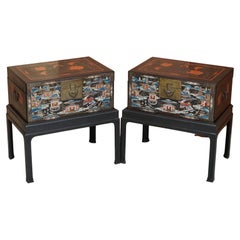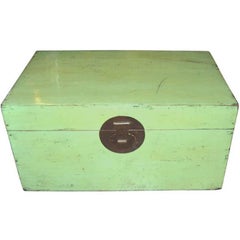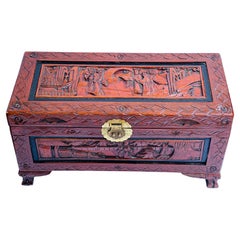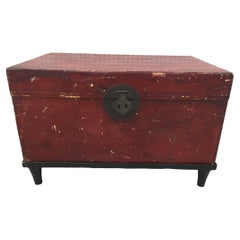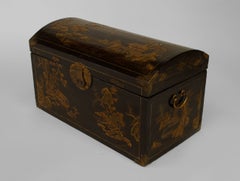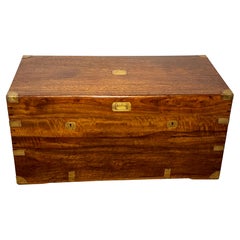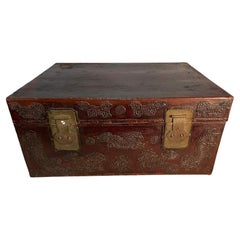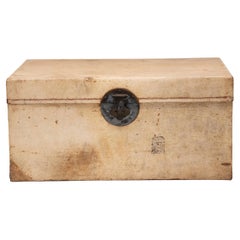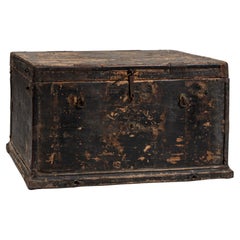Antique Chinese Trunks
Early 1900s Chinese Victorian Antique Chinese Trunks
Elm
19th Century Chinese Antique Chinese Trunks
Wood
1910s Chinese Chinoiserie Antique Chinese Trunks
Wood
Late 19th Century Chinese Chinese Export Antique Chinese Trunks
Iron
19th Century Chinese Antique Chinese Trunks
Gold Leaf
19th Century Chinese Chinese Export Antique Chinese Trunks
Brass
Late 19th Century Chinese Qing Antique Chinese Trunks
Bronze
Early 19th Century Chinese Minimalist Antique Chinese Trunks
Brass
Early 20th Century Chinese Rustic Antique Chinese Trunks
Iron
19th Century Chinese Antique Chinese Trunks
Leather, Pine
Early 19th Century Chinese Qing Antique Chinese Trunks
Brass
Early 19th Century Chinese Chinese Export Antique Chinese Trunks
Brass
1920s Chinese Antique Chinese Trunks
Wood
Late 18th Century Chinese Qing Antique Chinese Trunks
Metal
19th Century Chinese Antique Chinese Trunks
Leather
Early 20th Century Chinese Chinese Export Antique Chinese Trunks
Wood
Mid-19th Century Chinese Chinese Export Antique Chinese Trunks
Wood
Mid-19th Century Chinese Chinese Export Antique Chinese Trunks
Brass
Early 19th Century Chinese Qing Antique Chinese Trunks
Brass
Early 1900s Chinese Chinese Export Antique Chinese Trunks
Wood
Early 19th Century Chinese Antique Chinese Trunks
Brass
Mid-19th Century Chinese Antique Chinese Trunks
Wood, Lacquer
Late 19th Century Chinese Other Antique Chinese Trunks
Brass, Iron
1920s Chinese Chinese Export Antique Chinese Trunks
Silk, Wood
Late 19th Century Chinese Qing Antique Chinese Trunks
Bronze
Early 1900s Chinese Chinese Export Antique Chinese Trunks
Wood
1920s Chinese Chinese Export Antique Chinese Trunks
Wood
1820s Chinese Antique Chinese Trunks
Brass
1830s Chinese William IV Antique Chinese Trunks
Padouk
Late 19th Century Chinese Chinoiserie Antique Chinese Trunks
Bronze
Early 20th Century Chinese Antique Chinese Trunks
Brass
1920s Chinese Ming Antique Chinese Trunks
Brass
19th Century Chinese Antique Chinese Trunks
Brass
Early 20th Century Chinese Antique Chinese Trunks
Brass
19th Century Chinese Antique Chinese Trunks
Brass
Late 19th Century Indonesian Antique Chinese Trunks
Wood
19th Century Chinese Antique Chinese Trunks
Leather
19th Century Chinese Qing Antique Chinese Trunks
Brass
Early 20th Century Chinese Qing Antique Chinese Trunks
Brass
19th Century Chinese Qing Antique Chinese Trunks
Brass
Late 19th Century Unknown Chinese Export Antique Chinese Trunks
Wood
Late 19th Century Chinese Late Victorian Antique Chinese Trunks
Tin
Early 20th Century Chinese Rustic Antique Chinese Trunks
Metal
19th Century Korean Chinese Export Antique Chinese Trunks
Brass
Early 20th Century Chinese Antique Chinese Trunks
Brass
Late 19th Century Chinese Export Antique Chinese Trunks
Other
Early 19th Century Chinese Qing Antique Chinese Trunks
Wood
1880s Antique Chinese Trunks
Leather
Early 20th Century Chinese Antique Chinese Trunks
Hardwood
19th Century Chinese Antique Chinese Trunks
Brass
Mid-19th Century Chinese Antique Chinese Trunks
19th Century Chinese Antique Chinese Trunks
Leather
Early 20th Century Chinese Antique Chinese Trunks
Rattan
Early 1900s Chinese Antique Chinese Trunks
Leather
19th Century Chinese Antique Chinese Trunks
Early 1900s Chinese Antique Chinese Trunks
Leather
Early 20th Century Chinese Antique Chinese Trunks
Wood
19th Century Chinese Antique Chinese Trunks
19th Century Chinese Antique Chinese Trunks
Late 19th Century Chinese Antique Chinese Trunks
Willow
- 1
Antique Chinese Trunks For Sale on 1stDibs
Finding the Right Trunks-luggage for You
Add a charming piece of travel history to your space. Antique and vintage trunks and luggage can make a statement as decorative accents and practical furnishings in nearly every room of your home.
There have been many types of trunks and luggage over the years, with availability of these wares broadening as train travel expanded during the 19th century. Antique steamer trunks — named for their use on steamships — mostly date from around 1880 to 1920. These pieces of luggage fit a steamship’s luggage size regulations and essentially doubled as wardrobes, ensuring that a traveler’s evening dresses and suits were kept wrinkle-free on a journey from city to city.
In 1858, French luxury brand Louis Vuitton introduced the world to the now-iconic Louis Vuitton trunks. During this early period of railroad travel, Louis Vuitton trunks solved common travel problems. Instead of the traditional round shape, these handcrafted rectangular trunks stored better on trains. To discourage burglars, the French craftsman and his son, Georges, also eventually patented a revolutionary sophisticated lock for the trunks. The famous LV monogram was first used in 1896 as part of an initiative by Georges to prevent counterfeiting of his coveted travel trunks.
Even if no longer used for travel, the vintage luggage is a popular item among collectors for its historical value and charm. At home, an old wood trunk is a durable storage solution as much as it is a versatile surface. It’s a coffee table in the living room of your farmhouse-style home or rustic loft apartment and a nightstand or blanket chest at the foot of your bed in your bedroom.
From Victorian trunks to Art Deco traveling jewelry cases, journey through history today with an extensive collection of antique trunk suitcases and vintage luggage on 1stDibs.
 PAGODA REDOctober 7, 2020
PAGODA REDOctober 7, 2020To determine the age of a Chinese furniture piece, look carefully at the joinery and finish. Natural expansion and contraction of the wood over time will cause a joint to protrude or retract, distorting a once-seamless fit. Antique lacquer finishes become crackled and worn over time. Areas of exposed wood, such as the underside of a table, the footrest of a chair, or the back of a cabinet should appear raw and dry compared to the finished surface. With use, the legs of tables and chairs become weathered near the bottom from precipitation and use.
 Lotus GallerySeptember 23, 2020
Lotus GallerySeptember 23, 2020The best way to know is to take it to an expert, such as an appraiser, reputable dealer or auction house, or museum
- 1stDibs ExpertNovember 4, 2024To identify antique Chinese furniture, look carefully at its details. Chinese craftsmen often built furniture using mortise and tenon joinery, eliminating the need for nails and screws. If you see this type of hardware, your piece is likely not at least 100 years old, especially if the hardware still looks new and shiny. Since antique furniture was handmade, you will normally see slight imperfections, such as tool marks or slight variations in carvings. Pieces that appear completely uniform and pristine are less often genuine antiques.
When present, maker's marks can also be helpful. Research the marks to learn more about when the maker was active and producing pieces like yours. Alternatively, you can have a certified appraiser or experienced antique dealer evaluate your furniture for you.
Shop an assortment of antique Chinese furniture.
Read More
Medal-Worthy Memorabilia from Epic Past Olympic Games
Get into the games! These items celebrate the events, athletes, host countries and sporting spirit.
Ahoy! You’ve Never Seen a Collection of Sailor Art and Kitsch Quite Like This
French trendsetter and serial collector Daniel Rozensztroch tells us about his obsession with objects related to seafaring men.
39 Incredible Swimming Pools
It's hard to resist the allure of a beautiful pool. So, go ahead and daydream about whiling away your summer in paradise.
Pamela Shamshiri Shares the Secrets behind Her First-Ever Book and Its Effortlessly Cool Interiors
The sought-after designer worked with the team at Hoffman Creative to produce a monograph that beautifully showcases some of Studio Shamshiri's most inspiring projects.
Moroccan Artworks and Objects Take Center Stage in an Extraordinary Villa in Tangier
Italian writer and collector Umberto Pasti opens the doors to his remarkable cave of wonders in North Africa.
Montecito Has Drawn Royalty and Celebrities, and These Homes Are Proof of Its Allure
Hollywood A-listers, ex-pat aristocrats and art collectors and style setters of all stripes appreciate the allure of the coastal California hamlet — much on our minds after recent winter floods.
Whaam! Blam! Pow! — a New Book on Pop Art Packs a Punch
Publishing house Assouline and writer Julie Belcove have teamed up to trace the history of the genre, from Roy Lichtenstein, Andy Warhol and Yayoi Kusama to Mickalene Thomas and Jeff Koons.
The Sparkling Legacy of Tiffany & Co. Explained, One Jewel at a Time
A gorgeous new book celebrates — and memorializes — the iconic jeweler’s rich heritage.
